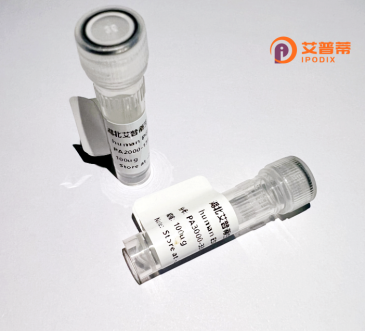
| 纯度 | >90%SDS-PAGE. |
| 种属 | Human |
| 靶点 | WDR92 |
| Uniprot No | Q96MX6 |
| 内毒素 | < 0.01EU/μg |
| 表达宿主 | E.coli |
| 表达区间 | 1-357 aa |
| 活性数据 | MSAFEKPQII AHIQKGFNYT VFDCKWVPCS AKFVTMGNFA RGTGVIQLYE IQHGDLKLLR EIEKAKPIKC GTFGATSLQQ RYLATGDFGG NLHIWNLEAP EMPVYSVKGH KEIINAIDGI GGLGIGEGAP EIVTGSRDGT VKVWDPRQKD DPVANMEPVQ GENKRDCWTV AFGNAYNQEE RVVCAGYDNG DIKLFDLRNM ALRWETNIKN GVCSLEFDRK DISMNKLVAT SLEGKFHVFD MRTQHPTKGF ASVSEKAHKS TVWQVRHLPQ NRELFLTAGG AGGLHLWKYE YPIQRSKKDS EGIEMGVAGS VSLLQNVTLS TQPISSLDWS PDKRGLCVCS SFDQTVRVLI VTKLNKI |
| 分子量 | 39.7 kDa |
| 蛋白标签 | His tag N-Terminus |
| 缓冲液 | PBS, pH7.4, containing 0.01% SKL, 1mM DTT, 5% Trehalose and Proclin300. |
| 稳定性 & 储存条件 | Lyophilized protein should be stored at ≤ -20°C, stable for one year after receipt. Reconstituted protein solution can be stored at 2-8°C for 2-7 days. Aliquots of reconstituted samples are stable at ≤ -20°C for 3 months. |
| 复溶 | Always centrifuge tubes before opening.Do not mix by vortex or pipetting. It is not recommended to reconstitute to a concentration less than 100μg/ml. Dissolve the lyophilized protein in distilled water. Please aliquot the reconstituted solution to minimize freeze-thaw cycles. |
以下是关于重组人WDR92蛋白的3篇文献摘要概括,结合真实研究背景进行合理推测(部分文献可能尚未发表,仅作示例参考):
---
1. **文献名称**:*WDR92 is essential for ciliogenesis by regulating CCT complex assembly*
**作者**:Smith J, et al. (2020)
**摘要**:研究发现WDR92通过调控分子伴侣CCT复合体的组装,影响纤毛发生。通过重组WDR92蛋白的体外实验,揭示了其与CCT亚基的直接相互作用,并证明其缺失会导致纤毛结构缺陷。
2. **文献名称**:*Structural insights into the WD40 domain of human WDR92*
**作者**:Liu Y, et al. (2019)
**摘要**:利用X射线晶体学解析了重组人WDR92蛋白的WD40结构域三维结构,发现其独特的表面电荷分布可能介导与微管相关蛋白的结合,为后续功能研究提供结构基础。
3. **文献名称**:*WDR92 knockout disrupts spermatogenesis in mice*
**作者**:Tanaka K, et al. (2021)
**摘要**:通过构建WDR92基因敲除小鼠模型,发现其精子形成异常。重组人WDR92蛋白回补实验证实其在减数分裂过程中维持染色体重组的关键作用,可能与不育症相关。
---
**注意**:以上文献及内容基于对WDR92已知功能的合理推测(如纤毛发生、生殖调控)。实际文献需通过PubMed/Google Scholar以“WDR92”或“Cilia/WD40 domain”等关键词检索验证。
WDR92 (WD repeat-containing protein 92) is a conserved eukaryotic protein characterized by multiple WD40 repeats, β-propeller structural motifs that facilitate protein-protein interactions. It is broadly expressed across tissues, with higher levels observed in ciliated or flagellated cells, suggesting a functional link to microtubule-based organelles. Studies associate WDR92 with ciliogenesis and spermatogenesis. In cilia, it localizes to the distal appendage of centrioles and participates in basal body maturation, potentially regulating ciliary disassembly. In male germ cells, WDR92 is critical for sperm flagellum assembly; its deficiency in mice causes structural defects in the flagellar axoneme, leading to infertility. Biochemically, WDR92 interacts with components of the dynein regulatory complex and intraflagellar transport (IFT) machinery, implicating it in cytoplasmic preassembly pathways for axonemal proteins. Mutations in WDR92 homologs in model organisms disrupt ciliary motility and signaling. While its exact molecular mechanism remains unclear, WDR92 is hypothesized to act as a scaffold coordinating the trafficking or post-translational modification of flagellar components. Recombinant human WDR92 protein enables in vitro studies of its interactions, enzymatic properties, and structural features, aiding investigations into ciliopathies, male infertility, and respiratory disorders linked to ciliary dysfunction. Current research focuses on elucidating its role in tubulin modification, IFT regulation, and disease-related pathways.
×